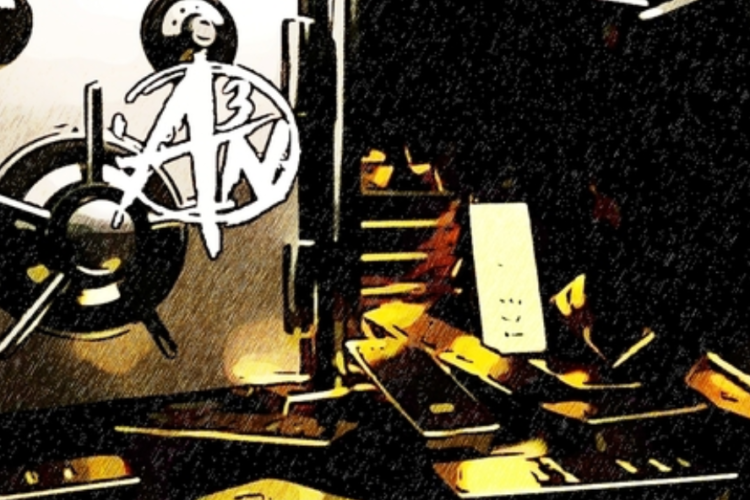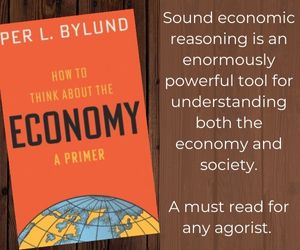
Anthony L. Hargis And The Trusted Third Party Trap
The anarchists who congregated around Samuel E. Konkin III (SEK3) and formed AnarchoVillage had innovative ways of making their money less visible to the state. They evolved systems of black-market money—that is, money that could be earned and spent under the table. Their activities undoubtedly brought them financial benefits but the primary motivations were political and moral. For years, they had a remarkable ally in their quest to circulate money safely and discreetly: Anthony L. Hargis. His financial business Anthony L. Hargis & Co. (ALH&Co) provides a cautionary tale, however, on what cryptocurrency calls the “trusted third party problem.”
SEK3 believed the path to freedom lay through peaceful “counter-economics”, which is virtually a synonym for the “black market.” This means that the counter-economic circulation of money becomes essential to personal freedom and to weakening the state by depriving it of sustenance. In his classic work on Agorism, New Libertarian Manifesto (NLM), SEK3 disposes of a common misconception about the black market; namely, it is violent. “While some coercive acts are often lumped into the label ‘black market’, such as murder and theft, the vast majority of this ‘organized crime’ is perfectly legitimate to a libertarian, though occasionally unsavory.” Drug dealing is an example.
NLM continues, “The Mafia, for example, is not black market but acts as a government over some of the black market which collects protection money (taxes) from its victims and enforces its control with executions and beatings (law enforcement), and even conducts wars when its monopoly is threatened. These acts will be considered red market to differentiate them from the moral acts of the black market…In short, the ‘black market’ is anything non-violent prohibited by the State and carried on anyways.”
But restricting economic activity to the black market raises a difficulty. Money flowing through the black market is usually considered illegal as well; certainly, the money is confiscated if the authorities learn of it. Mainstream financial institutions and practices are no longer safe and sometimes not available to an agorist. In the past, there have been four strategies by which agorists try to be discreet about the transfer of wealth. They barter as much as possible to reduce the need for money or paperwork that leaves a trail. They use ‘private’ forms of money, such as precious metals or IOUs, which operate outside the traditional system. They accept and pay only with cash, while jealously protecting their anonymity. They use financial institutions that take privacy seriously, as Swiss banks once did. All these options carry risk but without some means to circulate money, the black market is severely disadvantaged. And, so, people accept the danger of being mugged or otherwise attacked.
Science-fiction writer J. Neil Schulman was SEK3’s lieutenant and one of the founding members of AnarchoVillage. His first novel, Alongside Night, presents a dystopian society that is in economic collapse and exists in parallel with a thriving black market. Schulman perceived a problem, however. How does money circulate through the black market without recourse to fiat or traditional banks?
Schulman was well aware of ALH&Co. whose free-market bank—“a bank that wasn’t a bank”— operated for 28 years, by Hargis’s account. ALH&Co was founded in the mid-1970s as a “Massachusetts Business Trust.” This is legally defined as “an unincorporated business organization created by a legal document, a declaration of trust, and used in place of a corporation or partnership for the transaction of various kinds of business with limited liability,” in accordance with the terms of the trust. It is sometimes called an “unincorporated business organization” or a “free-market trust.” Hargis’s believed that a Trust holding gold accounts and using what he called “transfer orders” was legally different from a bank with accounts and checks in fiat. The Internal Revenue Service (IRS) views them as tax evasion.
Schulman clearly drew upon ALH&Co. as the agorist society his novel portrayed began to gel In his mind in 1974. Alongside Night describes a black market mall visited by Schulman’s young protagonist. “They began down the promenade, on the left passing the Black Supermarket (it looked like a supermarket); next to it, offices of the First Anarchist Bank and Trust Company—AnarchoBank for short.” Located on the trading floor of the Auxiliary Agorist Underground, the AnarchoBank is a Swiss subsidiary at a time when Swiss banks were still relatively private. Its user accounts are denominated in gold and linked offshore; the importance of gold to economic freedom is stressed. Schulman’s novel predicts the prohibition of privately owned gold with penalties of up to twenty years in jail, which merely makes ownership of gold more important, of course.
Hargis was equally committed both to gold and to secure money as prerequisites of financial freedom. Phil Osborn, a long-term associate of ALH&Co. and a friend to Hargis, explained “Anthony’s focus…was on the dishonesty and fraud… perpetrated by the Federal Reserve System, which he viewed as a giant scam and Ponzi scheme supported by the armed might of the U.S. and its international cabal.” Hargis wanted to get “people out of their dependence upon the Federal Reserve, and away from the use of ‘dollar’ accounting via gold-denominated accounts.” ALH&Co.’s accounts and services gave clients the chance to preserve their wealth against inflation; on the other hand, ALH&Co. was granted permission to invest the funds of depositors and shareholders in businesses that promoted the free market and were expected to turn a profit. It was an exchange many anarchists and libertarians willingly embraced. Located in Fountain Valley, California, ALH&Co.’s customers were mostly Californians, many of whom had met Hargis at conferences or other local meetings.
Yet, in person, Hargis did not look like a man set on sabotaging the monetary system. Unlike SEK3 who invariably dressed in black and answered his phone with “Smash the State,” Hargis dressed in a conservative casual manner in blue jeans, and he spoke in a soft, straight manner. Whereas SEK3 was tall and of an imposing size, Hargis was lanky and did not immediately leave a deep impression. A casting agent might have placed him in the role of an accountant because that was his appearance and attitude; he refused to do business with anyone who used illegal drugs, for example. And, yet, ALH&Co. was as agorist as anything that came out from AnarchoVillage.
Hargis was driven by deeply held principles. His essay “The Lost Right: Redress of Grievances” explains the history behind his position. “The sequence of ‘redress before taxes’ was well established in English law at a time when great numbers of Englishmen traveled to America. They brought with them the principle of ‘taxes with consent’…a collection of rights, such as redress, speech, assembly and trial by jury. The Magna Charta is universally represented as the origin of American founding documents…We would expect American courts to rule, in cases of redress, according to principles as developed and practiced in England—and yet they rule just the opposite, that taxes must be paid before redress. Where do American courts derive authority for such a ruling? For decisions of American courts to be lawful, they must be founded on, and consistent with, constitutional principles; otherwise, courts engage in law making, or constitution amending—either of which would constitute a grievance.” In short, Hargis believed Americans had a constitutional right to withhold taxes if a state did not redress their grievances. And the United States clearly did not.
Nevertheless, Osborn recalled “how painstakingly he went out of his way to discourage customers, shareholders, and potential trust creators…from thinking that they could use any or all of the above to evade taxes. This was a separate issue to be decided politically and in the courts. His business was providing people the option to keep savings denominated in gold, for the purpose of capital preservation, and to possibly have the opportunity to invest in businesses that were consistent with their moral principles.” Other customers say that Hargis never mentioned taxes to them. Both statements may well be true.
The services offered included the opportunity to invest in shares of ALH&Co. and to purchase kits on how to establish similar trusts for themselves. Hargis also provided instruction on how to terminate a social security number, but it is not clear whether the process detailed was effective. Some of Hargis’s ideas tended to be unrealistic and based on strange interpretations of history or law.
Nevertheless, the operations of ALH&Co. were set up in a practical manner; they were simple to use and a minimum of paperwork or information was required. Clients could choose between holding accounts in dollars or in gold, with the latter being a way to preserve capital against inflation. A popular feature was the “transfer order”–a type of internal check—that one customer gave to another or to a business that would accept it. The order provided an almost invisible exchange of wealth that did not go through traditional banks. ALH&Co. would also convert the orders into regular bank checks based on fiat.
Another popular feature of ALH&Co. was the so-called “warehouse banking.” The term was applied to the business by the Department of Justice (DOJ) in a letter dated December 9, 2004 through which the forced shutdown of ALH&Co. was announced; Hargis preferred the term “free-market banking.” The service consisted of Hargis receiving funds and depositing them into traditional bank accounts where the money commingled and protected the identities and transactions involved. Because the accounts were under Hargis’s name or that of an associate, ALH&Co. could honor customer instructions to pay regular bills, like mortgages, which was particularly valuable for those who traveled.
At one point, according to the DOJ, Hargis had about 253 clients and used nine commercial bank accounts, which were under his name or those of trusted associates. (The figures shift depending on the specific DOJ document or media item.) The Los Angeles Times estimated, “At the end of 2001, Hargis had about $7.2 million on deposit in nine commercial bank accounts in California and Texas, the complaint said.” Not providing records is what truly angered the state because it wanted to unmask Hargis’s customers.
In the early years, ALH&Co. operated its bank, gold depository and other investments without real door-crashing interference from state agencies. The IRS was certainly aware of his activities because agents visited his office occasionally and engaged in some harassment. Nevertheless, Hargis always seemed to satisfy their demands, perhaps because he haunted the Orange County Law Library and knew more about tax law than the state agents did.
Then, in May 1993, things changed. State agents descended on his office with machine guns, flak jackets, and accusations that Hargis was a money launderer and a drug dealer. The latter accusation probably came because he handled large amounts of undeclared money and that was considered evidence of dealing.
Accounts of the raid described the agents as breaking open the door even though it was unlocked. Some former customers have speculated that Hargis’s fresh involvement with a group that favored active tax protests—State Citizens—prompted the raid. Others pointed to a customer whose car was pulled over and an officer found a pile of cash along with a receipt from Hargis.
An underlying and more significant reason for the 1993 raid and the 2004 trouble, however, was what cryptocurrency calls “the trusted third party problem.” Trusted third parties are the authorities that verify the identity of exchanging partners and authorize an exchange to occur. The authority can be a free-market one, like a lawyer upon whom both parties agree.
Both Satoshi Nakamoto (creator of Bitcoin) and Hargis were concerned about state authorities, especially the central banking system and Federal Reserve. In order to function in the modern economy, the average person had to surrender all privacy through data harvesting and to endure the depletion of his wealth through mechanisms such as inflation. Central banking and the Federal Reserve acted as proxies for the state. Banks turned in all records to authorities, flagged suspicious customers and allowed the state to confiscate accounts. The Federal Reserve was key to determining the economic flow through society, which was the flow of life itself. The central banks also enforced social control as the trend to deny services to “immoral” business—sex workers or marijuana shops, for example—even if the business operated legally.
Yet, in practical terms, what choice did average people have? How could a a person or business conduct commerce with a payee who was hundreds or thousands of miles away without some form of long-distance transfer system? The state monopolized most of them in one way or another and criminalized the few that remained. Non-compliant people would be reduced to clumsy exchanges like barter or dangerous ones. In short, trusted third parties became “security holes”–choke points that obstructed freedom and economic progress to benefit the state and other elites.
Nakamoto’s purpose in constructing Bitcoin was to create a private currency that individuals controlled—much as they controlled transfer orders—but which obviated the trusted third party problem by functioning peer-to-peer over long distances. This made the state and proxies irrelevant to exchanges. His White Paper launched the crypto phenomenon in late 2008. It opens, “A purely peer-to-peer version of electronic cash would allow online payments to be sent directly from one party to another without going through a financial institution. Digital signatures provide part of the solution, but the main benefits are lost if a trusted third party is still required.”
Both Nakamoto and Hargis tried to provide the average person with a choice to say “no” to an unjust system without economically crippling themselves. ALH&Co offered many of the same benefits as crypto: privacy, protection from traditional banks and from the state, as well as the enhanced ability for individuals to control their own wealth. But ALH&Co. embodied the trusted third party problem in at least three ways.
First, and without casting aspersion on Hargis’s integrity, involving a trusted third party in an exchange always introduces risk. An honest third party may be incompetent or indiscreet, for example. Risk is a part of life. It cannot be totally eliminated, but it can be drastically reduced. One means of doing so is through technology such as encryption. Here, Hargis made a grievous mistake, not only for himself but for his customers who paid dearly for his blindness. Kent Hastings, a long-term friend of SEK3, posted his frustration with Hargis to the Cryptoanarchy Wiki regarding the 1993 confiscation of records. “The computer records were not encrypted, despite my, and others, frequent suggestions. ‘Citizens don’t need encryption’ was the [Hargis’s] response in a nutshell.” Hastings concluded, “Citizens Do. Now, secure physical data links (perhaps using spread-spectrum modulation of radio and microwave) appear necessary for financial privacy. All the nice little tricks with mail drops and trusts may work in the short term, but only strong encryption and signal hiding will insure long term survival.”
Second, ALH&Co. was brick and mortar. It had a street address, postal delivery, an email address, and a phone number that led to Hargis and that led to his customers. The ease of finding Hargis made a raid on his business far more likely. By contrast, peer-to-peer transfers over a digital ledger are difficult to raid, especially if the exchanging parties take precautions such as using different addresses for each transaction.
Third, Hargis used traditional bank accounts to commingle the money of clients and pay their bills. These activities could and were traced by the state in the 2004 persecution. Again, people looked elsewhere for the cause of Hargis’s final persecution. A prime suspect was a Seattle man accused of running a warehouse bank out of his home. According to FOX News, “The IRS agent noted that a $7,500 check Sambol deposited in 2004 was made out to him by ALH & Co. — a warehouse banking scheme run by Anthony L. Hargis, of Fountain Valley, Calif. Federal agents dismantled Hargis’ operation later that year.” Presumably, the check was from one of the mainstream bank accounts, which made it eminently traceable.
In early March 2004, the DOJ sued Hargis in the District Court in Santa Ana for allegedly running a fraudulent warehouse banking scheme that helped customers hide from the IRS. By March 10, 2004, the IRS had gathered information on 14 clients, who were said to “owe” $1.36 million in taxes or about $97,000 per customer. If this is an average amount per person, then Hargis’s customers allegedly “owed” a total of more than $24 million in back taxes. A week later another DOJ announcement read, “The court in December 2003 ordered Hargis to turn the records over. Yesterday, after a hearing, Judge David O. Carter of the U.S. District Court for the Central District of California found Hargis in contempt of court for failing to do so, and Hargis was taken into custody immediately” and indefinitely until he complied. He was never criminally charged with anything.
It was a mistake to offer his clients a service that involved a proxy for the state—that is, a mainstream bank. This mistake exposed ALH&Co.’s customers to harassment, confiscation of wealth, accusations of tax evasion or money laundering, and possible imprisonment. In 2004, Hargis was asked why so few of his former customers came to his defense. He responded, “The answer is complex. Unfortunately most people in the freedom movement have a foxhole mentality….Another factor is just plain fear of the IRS. An attorney friend contacted 6-8 other attorneys about helping and when they learned the IRS was involved they said, ‘No way!’ More, the IRS has indicated in its filings that it intends to audit every one of my customers/supporters. Who can blame them for wanting to avoid publicity? For not supporting me? It’s the Catholic Inquisition with a different name.”
Elsewhere, he warned former customers, “Please understand, your life, literally, is at stake here. The government is really ticked off that we have operated/exercised rights for twenty-eight years; and is determined to make a real bloody example of all of us. The only reason for this release [from jail] is because the government took everything it could find that was connected to me: this included bank accounts, real property, the office and its related postal and e-mail addresses, and telephone. This means that everyone who tries to communicate with me at my old address will reach the IRS instead—and those at the office will represent themselves as working for [ALH&Co.].”
Hargis spent about six months in jail during which time, the federal agencies confiscated his property—including all customer deposits—and stole his records. Assets were ultimately awarded to the IRS by the court, including accounts held in outside banks, with investors losing everything. ALH&Co’s customers and shareholders were contacted by state agents, with a Receiver’s Petition being issued.
(Note: the Notice of Receiver’s Petition alleges a customer base of 1190, which may reflect the fact that many customers used different services. Or, perhaps, it reflects the totality of customers over close to three decades. How many shareholders existed is not stated. Because the records were not made public, some of the information is the best that can be gleaned from snippets of information and first-hand accounts.)
In a March 16, 2006 update, Osborn informed readers, “Last I heard, Anthony is now penniless and has a claim against him by the IRS of some $30 million or so. [Hargis called the $33 million state-assessed tax liability “a fabricated fairy-tale.”] His total assets, at the time that the Feds seized everything, were possibly worth an estimated $7 million. The seizures resulted in the loss of a good portion of those assets, apparently, as various businesses shut down, etc., leaving perhaps $2 million, it appears, from the final liquidation by the Receiver.”
Who were the Hargis customers? They included the rich but most of them were average working people or small businessmen who were neither rich nor poor. Osborn described one. “Bruce, who was a personal friend, although not really close, ran a small printing business, specializing in high quality prints, that had apparently taken out a loan from ALH&Co. and then paid it back. On that basis, as far as I can tell, Bruce was alleged to be some kind of co-conspirator with Anthony’s evil criminal empire, and, I was just told this past weekend, hit in 2004 with a $ million in penalties, somehow. The entire assets of the business, which was just barely scraping along like so many small traditional print shops in the digital age.” Bruce died of heart failure in his late 40’s.
The economic tragedy that happened to Hargis and his customers is a human tragedy that ruined lives. It would have been far, far less likely to have happened without the trusted third party problem. Crypto is financial and financial freedom without the risk that ALH&Co’s clients assumed. The genius of Bitcoin was to remove the trusted third party problem from transactions, which removed most of the vulnerability exchanges have to common criminals and the state. The value of being able to bypass trusted third parties cannot be overstated.









